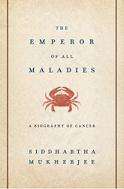The Emperor of All Maladies
|
Cover of The Emperor of All Maladies | |
| Author | Siddhartha Mukherjee |
|---|---|
| Country | United States |
| Language | English |
| Subject | Cancer |
| Genre | Non-fiction |
| Publisher | Scribner |
Publication date | 16 November 2010 |
| Pages | 592 |
| ISBN | 978-1-4391-0795-9 |
The Emperor of All Maladies: A Biography of Cancer is a book written by Siddhartha Mukherjee, an Indian-born American physician and oncologist. Published on 16 November 2010 by Scribner, it won the 2011 Pulitzer Prize for General Non-Fiction: the jury called it "an elegant inquiry, at once clinical and personal".[1][2][3]
Content
The book weaves together Mukherjee's experiences as a hematology/oncology fellow at Massachusetts General Hospital as well as the history of cancer treatment and research.[3][4] Mukherjee gives the history of cancer from its first identification 4,600 years ago by the Egyptian physician Imhotep. The Greeks had no understanding of cells, but they were familiar with hydraulics, so they used hydraulic metaphors, of humors, which were fluids whose proper balance, they believed, produced health and sickness. According to the book, cancer existed in silence in history until 440 before the Common Era, where the Greek historian Herodotus records the story of Atossa the queen of Persia and the daughter of Cyrus, who noticed a lump in her breast. The tumor was excised by her Greek slave named Demasitis, where the procedure is believed to be successful at least temporarily.
In the 19th century, surgical approaches were developed to deal with tumors. William Halsted developed an aggressive, disfiguring breast surgery as a strategy for removing not only existing cancer cells but also places to which they might have spread.
Leukemia, a cancer of blood cells, was first observed by Rudolph Virchow, and Franz Ernst Christian Neumann localized the pathology to the bone marrow. Leukemia cells are dependent on the enzyme dihydrofolate reductase. Sidney Farber used molecules developed by Yellapragada Subbarow to block the enzyme and destroy the leukemia cells, producing a temporary remission in the disease.
The book proceeds right on through to the latest research and therapies.
According to Mukherjee, the book was a response to the demand of a patient: "I’m willing to go on fighting, but I need to know what it is that I’m battling."[5] Mukherjee states that two of his influences for the book were Randy Shilts' And the Band Played On and Richard Rhodes' The Making of the Atomic Bomb, but the defining moment for him was "when he conceived of his book as a biography".[5]
It was described, by the magazine TIME, as one of the 100 most influential books of the last 100 years,[6] and by The New York Times magazine as among the 100 best works of non-fiction.[7]
Awards and honours
.jpg)
- 2011: Pulitzer Prize for General Non-fiction, winner
- 2011: PEN/E. O. Wilson Literary Science Writing Award, winner (inaugural)
- 2011: Guardian First Book Award, winner
- 2011: Wellcome Trust Book Prize, shortlist[8]
- 2010: New York Times Best Books of the Year
- 2010: New York Times Notable Book of the Year
- 2010: New York Times Bestseller
- 2010: TIME Magazine's Best Books of the Year
- 2010: National Book Critics Circle Award, finalist
- 2010: Los Angeles Times Book Prize, finalist
Translations
- 2011: Italian: L' imperatore del male. Una biografia del cancro, Neri Pozza (ISBN 978-88-545-0331-1).
- 2011: Korean: 암 : 만병의 황제의 역사, 이한음 (ISBN 978-89-7291-506-5).
- 2012: German: Der König aller KrankheitenBarbara Schaden (ISBN 978-3832196448).
- 2012: Lithuanian: Visų ligų karalius: vėžio biografija, leidykla "Versus aureus" (ISBN 978-9955-34-352-3).
- 2012: Portuguese: O Imperador de Todos os Males. Uma biografia do cancro, Bertrand Editora (ISBN 9789722523943)
- 2013: French: L'empereur de toutes les maladies. Une biographie du cancer, Éditions Flammarion (ISBN 978-2081285446).
- 2013: Dutch: De keizer aller ziektes, een biografie van kanker, de Bezige Bij (ISBN 978-9023472896).
- 2013: Russian: Царь всех болезней. Биография рака, АСТ, ISBN 978-5-17-077569-9
- 2013: Ukrainian: Імператор усіх хвороб: біографія раку, Київ, видавництво Жупанського (ISBN 978-966-2355-36-9).
- 2013: Polish: Cesarz wszech chorób: Biografia raka, Wydawnictwo Czarne (ISBN 978-83-7536-544-3)
- 2013: Bulgarian: Императорът на всички болести: Биография на рака, Изток - Запад (ISBN 978-619-152-315-3)
- 2014: Swedish: Lidandets konung: Historien om cancer, Albert Bonniers Förlag (ISBN 9789100132699).
- 2015: Persian: "سرطان امپراطور بیماریها", The House of Biology (ISBN 978-600-6926-36-0).
- 2015: Icelandic: "Meistari allra meina: Ævisaga krabbameins", Forlagið (ISBN 978-9979-53-617-8).
- 2015: Czech: "Vládkyně všech nemocí", Masarykova univerzita (ISBN 978-80-210-7761-4).
See also
References
- ↑ The Pulitzer Prizes. "The 2011 Pulitzer Prize Winners General Nonfiction". Retrieved 22 December 2012.
- ↑ "Indian doc's book on cancer wins Pulitzer Prize". Times of India. Boston. 19 April 2011. Retrieved 29 September 2011.
- 1 2 "An Oncologist Writes 'A Biography Of Cancer'". Fresh Air from WHYY. NPR. 17 November 2010. Retrieved 1 August 2011.
- ↑ Okie, Susan (28 November 2010). "Review: "The Emperor of All Maladies: A Biography of Cancer," by Siddhartha Mukherjee". Denver Post. Retrieved 29 September 2011.
- 1 2 McGrath, Charles (8 November 2010). "How Cancer Acquired Its Own Biographer". The New York Times. Retrieved 22 December 2012.
- ↑ http://entertainment.time.com/2011/08/30/all-time-100-best-nonfiction-books/slide/the-emperor-of-all-maladies-by-siddhartha-mukherjee/
- ↑ http://6thfloor.blogs.nytimes.com/2011/06/17/as-if-you-dont-have-enough-to-read/
- ↑ Joanna Bourke (10 October 2011). "2011 Wellcome Trust Book Prize shortlist". The Lancet. Retrieved 30 September 2012.
External links
- Mukherjee, Siddhartha (29 October 2010). "The Riddle of Cancer Relapse: The Cancer Sleeper Cell". The New York Times. Mukherjee's New York Times Magazine article based on his book.
- The Emperor of All Maladies on Open Library at the Internet Archive

- Discussion of The Emperor of All Maladies with Mukherjee, February 18, 2011
- Discussion of The Emperor of All Maladies with Mukherjee, September 25, 2011
